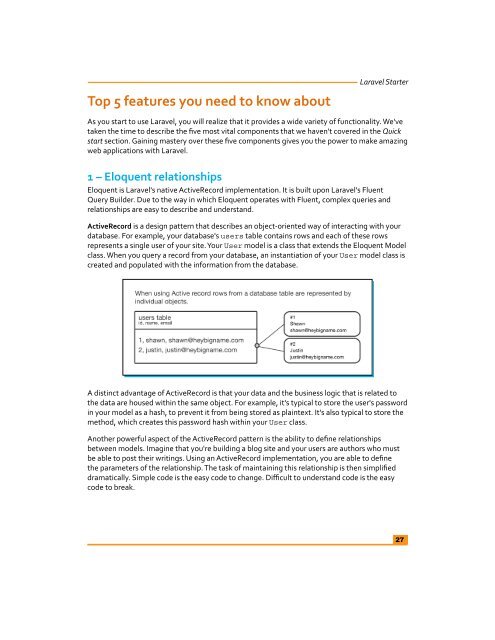Laravel Starter - PHP User Group (Myanmar)
Laravel Starter - PHP User Group (Myanmar)
Laravel Starter - PHP User Group (Myanmar)
Create successful ePaper yourself
Turn your PDF publications into a flip-book with our unique Google optimized e-Paper software.
Top 5 features you need to know about<br />
<strong>Laravel</strong> <strong>Starter</strong><br />
As you start to use <strong>Laravel</strong>, you will realize that it provides a wide variety of functionality. We've<br />
taken the time to describe the five most vital components that we haven't covered in the Quick<br />
start section. Gaining mastery over these five components gives you the power to make amazing<br />
web applications with <strong>Laravel</strong>.<br />
1 – Eloquent relationships<br />
Eloquent is <strong>Laravel</strong>'s native ActiveRecord implementation. It is built upon <strong>Laravel</strong>'s Fluent<br />
Query Builder. Due to the way in which Eloquent operates with Fluent, complex queries and<br />
relationships are easy to describe and understand.<br />
ActiveRecord is a design pattern that describes an object-oriented way of interacting with your<br />
database. For example, your database's users table contains rows and each of these rows<br />
represents a single user of your site. Your <strong>User</strong> model is a class that extends the Eloquent Model<br />
class. When you query a record from your database, an instantiation of your <strong>User</strong> model class is<br />
created and populated with the information from the database.<br />
A distinct advantage of ActiveRecord is that your data and the business logic that is related to<br />
the data are housed within the same object. For example, it's typical to store the user's password<br />
in your model as a hash, to prevent it from being stored as plaintext. It's also typical to store the<br />
method, which creates this password hash within your <strong>User</strong> class.<br />
Another powerful aspect of the ActiveRecord pattern is the ability to define relationships<br />
between models. Imagine that you're building a blog site and your users are authors who must<br />
be able to post their writings. Using an ActiveRecord implementation, you are able to define<br />
the parameters of the relationship. The task of maintaining this relationship is then simplified<br />
dramatically. Simple code is the easy code to change. Difficult to understand code is the easy<br />
code to break.<br />
27




